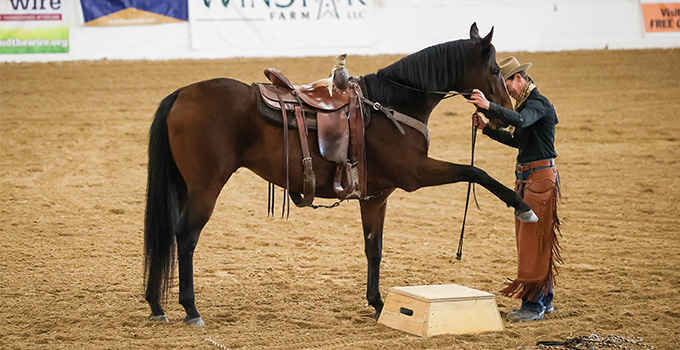Jody Busch has likely spent more time in the saddle than anywhere else. Riding six horses a day does that to a person.
Busch, the owner and operator of Jody Busch Horsemanship in Saskatoon, Sask., takes in retired thoroughbred racehorses and retrains them to be everyday riding horses for clients with her off-track thoroughbred team, Good Start OTTB training, which also includes veteran rider and trainer Anne Hagey.

Having worked in the business for more than 20 years, Busch’s innate equine understanding brings success to even the most challenging animals, turning them into dependable riders for their owners. She also provides riding lessons, clinics and ranch camps.
The retraining process: patience and precision
On average, it takes Busch nine to 12 months to completely retrain a former racehorse. The process is always gradual, which is critical to the horse understanding a new way of being, especially since they will run far less than they did in their past career.
She partners with Co-op to help develop a strong, tailored diet to bolster the horses’ nutrition during training. She feeds the animals mixed hay, salt and the CALIBER® Working Horse Ration.
“I like Caliber’s high protein, which helps build muscle, and it’s low starch,” she said. “The more we learn about horses and how they biologically function, the more we realize what and how much you feed them is really important. You need the right balance of nutrition.”
Most commonly, Busch trains quarter-horses, but also thoroughbreds and warmbloods. For Busch, her beloved breed is thoroughbreds, which she fell in love with for their athleticism and intelligence.
For the love of thoroughbreds
“They have a great balance of the hotness and the quickness that you get in the hot-blooded breeds, but they’re not wild and crazy,” she said. “I don’t like a horse that I have to beg to go. I like a horse that’s willing to go, and that’s a thoroughbred.”
The biggest joy of working with the animals is the keen sense of accomplishment during and after retraining. Busch’s favourite aspect of horses is their honesty.
“They wear their emotions on their sleeve,” she said. “They’re not going to deceive you. They just try to get along and do their best. If you can help them understand what it is you’re looking for, they’re willing to do it.”
A nutritional edge for active horses
The Caliber lineup caters to every owner, whether they run mares or pasture horses. It’s what Amanda Van De Kerckhove, a Ruminant Nutritionist with Co-op, had in mind when she helped create the products.
As Busch and others are on active horses, Van De Kerckhove believes Caliber’s Working Horse ration is simply the best option available.
“It’s my go-to recommendation nine times out of 10 for horse owners,” she said. “It’s a very nutrient-dense product, so it has a very high proportion of nutrition in the relatively low feeding rate.”
The recommended one to four pounds per day feed rate is lower than all other Caliber products, but still carries a high concentration of essential amino acids, minerals and vitamins, along with added omega-3 fatty acids from extruded flax meal. It also has low non-structural carbohydrate content, making it a flexible option for horses with sugar and starch sensitivities, such as those with equine metabolic syndrome.
“Caliber fits the bill for most scenarios that we’re working with,” said Van De Kerckhove. “They are good quality feeds, made in Western Canada with Western Canadian ingredients formulated by Western Canadian nutritionists.”
Talk to your local Co-op Feed Team member to find out if Caliber Working Horse is right for you.

